|
|
The instructions given to the support staff for
the Postcard program were:
-
End each telephone conversation with a customer with a phrase something like,
-
"Send us a postcard, let us know how you like our services," or
-
"Let us know how you liked our services, send us a postcard. Type 'postcard' at the PROFS main menu," or
-
"I'm sorry you are not satisfied with our services,
will you please send us a postcard, and let us how we need to improve.
Just type 'postcard' at the PROFS main menu."
-
Each person who has personal contact with customers should have a supply of paper postcards. The paper postcards come from Manager, End User Support. If you don't have any postcards, be sure to ask for them.
-
Carry blank postcards with you when you work outside of End User Support offices.
- Leave a postcard behind after you work on a customer's work station.
- Ask the customer to complete the postcard and send it through internal mail.
-
Do not expect the customer to complete the postcard while you are present,
and do not ask them to complete the postcard while you wait.
Having you standing over them while they complete the card
may alter the customer's response,
and we do not want this.
On the other hand, if a customer insists you accept a completed postcard,
take it to the Manager, End User Support immediately,
or simply drop it in the mail.
The postcards can be mailed via internal mail.
-
The closing of your PROFS notes on the PROFS system should read as follows:
How are we doing? ... Please let us know ...
... type "postcard" at the PROFS Main Menu
Include a paper postcard in the package for every item mailed
to the customer.
Every time you are in a conversation where satisfaction
or dissatisfaction with support services is expressed,
remind people to send a postcard, either paper or electronic.
This is true whether the conversation is in the hallway, in a meeting,
or on BART during your morning commute.
Preferably the topic will be end user support.
However, we (End User Support) will accept a complaint
about anything related to our company's computer services.
Most of the time, the Help Desk staff will keep a logon message on the VM System.
The most common form of the message is shown below.
::::::::::::::::::::::::::::::::::::::::::::::::::::::::::::::::::::::::
:: ::
:: Help us provide better support for PROFS, Personal Computers, ::
:: Local Area Networks, and all other [company-name] computer ::
:: systems. Give us your comments about the support services you ::
:: receive from [us], and how we can better serve you. To send your ::
:: comments, please type 'postcard' at the PROFS main menu. ::
:: ::
::::::::::::::::::::::::::::::::::::::::::::::::::::::::::::::::::::::::
Please use discretion if other logon messages are also being broadcast at the same time.
Customers who dial in at slow speeds find lengthy messages offensive.
|
|
The Manager's Role in the Customer Satisfaction Po
| |
|
The manager's role is customer satisfaction is crucial.
My staff took their cues from me,
in deciding how much emphasis to put on this program.
Telling them that customer satisfaction was important had no real lasting effect.
Only when I lived and breathed customer satisfaction every day would they come to believe I meant it.
| |
|
Daily
| |
|
These are the things that I did daily, as the Manager, End User Support.
| |
|
| |
|
- Make sure everyone had a supply of postcards.
Send paper postcards to End User Support staff who are
in remote locations.
Restock the dispensers.
Log the number of cards added to each dispenser.
| |
|
- Remind customers to send postcards.
I also had frequent customer contact.
The comment above about BART, above, is not facetious.
It was quite common for a disgruntled computer user to tell me
their frustrations on the way home.
Sometimes customers would call me just to complain.
I would often help them frame their frustrations into an action-able
postcard comment.
We would accept a postcard about any aspect of computer services,
whether it pertained to my department or not.
If I received a comment about another department,
I would send it to the manager of that department.
Sometimes a manager would resent my appearance with a problem for them.
However, I generally got pretty good cooperation from the other managers.
|
 Completed electronic postcard. Completed electronic postcard.
|
- Receive all postcards sent.
The format of the electronic postcard, as received by the manager
is shown at left.
| |
|
-
As the manager
I personally read all cards received at least once a day.
Generally this was done first thing in the morning.
Cards that represent actionable complaints can get acted upon immediately.
And the staff knows you are checking.
It really gets their attention when you step into their cubicle
first thing in the morning with a postcard from yesterday.
| |
|
- All postcards were logged as they were read.
The log was kept on the LAN.
A sample of this work sheet is shown in the
Appendix.
The work sheet was accessible to any End User Support staff.
However, I don't have the sense that many of them ever regularly
looked at it on the LAN.
As you will see below, they had other effective ways to find out
what cards were being received.
| |
|
-
I acknowledged about half of the postcards received.
Some could not be acknowledged because they were anonymous.
Others, that might just be three happy faces, I did not acknowledge either.
Cards that were complimentary to a staff member were acknowledged immediately,
with a comment like,
"Thanks for the happy faces for Louis, I'll pass your comments on to him."
Cards that were complaints were also acknowledged.
The kind of acknowledgment depended on the type of complaint
and what kind of organizational response we could make.
Postcards are most commonly acknowledged through electronic mail.
Sometimes the acknowledgment would be by telephone,
but the telephone is usually reserved for times more information is needed.
An example might be the case of a somewhat vague complaint,
in which case clarification is sought by telephone.
| |
|
| |
|
-
A postcard that indicated a problem would be acted on immediately.
The kind of action depended upon the problem.
The kinds of actions I might take included:
- Send immediately to the appropriate staff to resolve the problem.
If a specific individual who should address the problem
can be identified from the text of the customer comments,
the postcard is sent directly to them.
Sometimes a person in a group rather than a single individual should work on a problem.
For example, if the text of the postcard implies that the Help Desk should
resolve the problem, the postcard is sent to the Help Desk.
However, the Team Leader is not always at the Help Desk.
To prevent a problem postcard from languishing without action,
the Help Desk was called
and the postcard forwarded to the lucky person who answered.
-
If resolution of the problem should be tracked through
the problem management system,
the Postcard is sent to the appropriate party,
and they are asked to open a problem, reporting back
with the problem management system record number.
Alternatively, the Manager, End User Support may open the problem record
and place it in the appropriate problem queue.
|
|
- On postcards than indicate an old problem that is not getting resolved,
especially those that bounce around from queue to queue,
the Manager will escalate the problem to a high enough level in the
organization to encompass all parties required to provide a solution.
This is what was done with Postcard #43, below.
| |
|
| |
|
Weekly
The End User Support staff meeting was every Tuesday at 11:00 am.
The entire organization, including the Help Desk,
was shut down for an hour to an hour and a half.
(We were, however, immediately available for any user-described emergency.)
| |
|
The first order of business at the staff meeting was the current postcard summary.
I brought copies of the current worksheet,
like that shown in the Appendix.
As each person entered the room, they would pick up a copy, sit down,
and read each card.
The room was silent for a few minutes as people read the worksheet.
Then we would begin to discuss the postcards.
Someone would giggle; another would call out, "I like number 12," etc.
Someone else might say, "What happened on number 26?"
One-by-one, nearly every postcard would be discussed.
| |
|
Very often a postcard would be the starting point for a discussion about
a problem we were having.
I tried to let the table have a good discussion of the issues,
and then guide the discussion to synthesize a solution.
| |
|
Sometimes the postcards would consume only a few minutes of a staff meeting.
Other times nearly the whole meeting revolved around a postcard,
or a larger issue that was represented in a customer's comments.
I think the key point is:
we heard the voice of our customer as the first order of business
in every staff meeting.
| |
|
Monthly
At the end of every month, a final worksheet was prepared
and distributed to every staff member.
Summary statistics were transferred to a spreadsheet
and several charts were prepared.
|
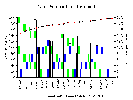 Chart of Postcards Sent Out and Returned. Chart of Postcards Sent Out and Returned.
|
The first chart shows the number of postcards sent out versus returned.
Some explanation is required.
The number of postcards sent out is the number of paper postcards.
The number of postcards returned is the sum of paper and electronic postcards.
The percentage of return is the number returned divided by the number sent out.
Since we sent out thousands of paper postcards in newsletters,
this number was quite low.
| |
|
As you can see, the number of postcards fell off the last few months.
This was because the group was being outsourced,
along with the rest of the Information Services department.
The outsourcer was expressing no interest in the postcard program,
and it was hard to maintain any enthusiasm for the customer satisfaction
program when people knew they would be losing their jobs.
However, the postcard customer satisfaction program was restarted
a year later when a critical customer satisfaction problem
developed with the outsourced Help Desk.
| |
|
Another thing that can be seen in this chart, though,
is that the volume of cards would often drop off.
I used this chart mostly to track the volume, and to have something to
point to when I was encouraging the staff to get more postcards flowing.
|
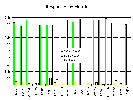 Postcard responses by month. Postcard responses by month.
|
The next chart shows the number of happy faces, versus neutral faces and sad faces.
| |
|
The purpose of this chart is to show that the overwhelming proportion of
responses were happy faces.
I did this chart specifically for my Vice President,
and called it to his attention each month.
| |
|
As you can see in this chart, the percentage of Happy Faces stayed at about 90% or more for 18 months.
I think this is about the maximum that can be expected over a long
period of time, and I also think 90% customer satisfaction is about the
minimum level to be considered "good."
|
 Percent of Sad Faces by Reason. Percent of Sad Faces by Reason.
|
The next chart begins to focus on the problem areas.
Specifically it displays the causes of sad faces
by the question to which to sad faces were marked.
Often a customer was either happy or unhappy,
in which cases they marked three happy faces or three sad faces,
respectively.
Sometimes, though, they would discriminate among the causes for their
satisfaction or dissatisfaction.
As a general rule, we got most sad faces for not being timely,
and least sad faces for not being friendly and helpful.
The last few months were anomalous because of the outsourcing.
|
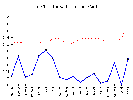 u-Chart for Sad Faces per Card. u-Chart for Sad Faces per Card.
|
The last chart is an attempt to be rigorous about the measurement of satisfaction.
We defined a postcard as a product which could have zero to three defects,
i.e., sad faces.
We then prepared a u-Chart for defects per product.
| |
|
I think this was the only statistical control chart ever prepared for
any process in the Information Services department.
The chart shows the process was out of control during the period
of April to November, 1993 because there are 8 points below the center line.
Actually, we had made some process improvements and should have recalculated
control limits from April 1993 on.
| |
|
Twice during this time period, we also categorized all comments received
by topic.
We then prepared pareto charts indicating causes of dissatisfaction
and requests for additional or improved services.
The primary conclusion was that our customers most wanted us to be
available when they needed us.
We addressed that need by combining our three help desks into one.
This permitted a sufficient depth of staff to keep the Help Desk fully staffed,
Monday through Friday, 8:00 am to 5:00 pm.
We also installed a multiple-level ACD telephone system.
This allowed the Help Desk to route telephone calls into other staff
areas when the volume of calls exceeded the capacity of those
working the Help Desk at that moment.
| |
|
Comments
There are a few general comments that I want to make about
help desk customer satisfaction and this program.
| |
|
It is my belief that most Help Desks provide good service to
the majority of their customers.
I have two data points to support this belief.
Both times I started this program, I was led to expect extremely
poor results.
However, the opposite occurred.
The first time I started this program, we received a 79% happy face rating.
The second time it was 74%.
Based on this data I believe most help desks provide valuable assistance
to their customers, and this assistance is appreciated.
| |
|
Let me quickly add that
there often remains much room for improvement, however.
In both cases improvements were needed in the telephone systems,
staff skills and procedures.
I believe a Help Desk customer satisfaction rating should be above 90%.
| |
|
I believe the bad reputation Help Desks receive is from a small proportion
of customers who will be unhappy at any level of service.
These people tend to be vocal and often have access to senior executives.
A corporate folklore that the Help Desk is lousy can be quickly established
and is hard to counter until you have real satisfaction data.
| |
|
In my first experience with this program,
my own Vice President boldly predicted that we would be
lucky to get a single happy face.
When we received 77 happy faces and only 10 sad faces
in our first month, July 1991,
he had to admit his surprise publicly.
He became an ally instead of an adversary.
| |
|
Regardless of our early success,
we still had a lot of work to do.
We combined three help desks into a single facility,
installed a new telephone system and problem management system,
cross-trained our staff, and built a new set of procedures.
Over time our support improvements resulted in 95% happy faces
being the norm.
| |
|
In the second time that I implemented this program,
customer dissatisfaction with the help desk had become
a critical issue at executive committee meetings.
There was, of course, no data about customer satisfaction;
only anecdotes from several (truly only 2 or 3) vocal people who,
I think, would never be satisfied with any level of service.
When some real data became available,
it became apparent to this executive committee that
many people were satisfied with the support received.
Help Desk customer satisfaction ceased to be an issue at the executive level.
To be honest, this support organization still had a lot of improvements
to make.
However, having some real data showing satisfied customers quickly
got the executive committee off their back, and let them make
improvements in an orderly program.
| |
|
There are a couple of issues that executives seem to raise about this system.
In my mind the common thread in these issues is executive fear
of the unknown or what they perceive to be uncontrollable.
| |
|
Every executive has resisted the implementation of this system.
My sense is that they fear asking the customers about satisfaction
will stir up a
maelstrom
of dissatisfaction.
This is unfortunate.
If the customers are truly so dissatisfied,
it can't be much worse by having an accurate count of the
dissatisfaction along with the name and phone number of
every dissatisfied customer.
(You can, at least, call them, or ... take them out to lunch!)
The facts, though, point to the opposite case.
Most customers like the services they are getting and
they are willing to say so.
| |
|
Having a lot of satisfied customers to balance out the vocal
dissatisfied customers puts some sanity back into the support business.
It puts you in the position of helping senior management achieve some
perspective about the complaints they hear.
It also allows you to manage the chronically dissatisfied.
They can put their dissatisfaction into words on the postcard,
or find themselves marginalized by the overwhelming proportion
of satisfied users.
| |
|
Occasionally an executive has worried about publishing the comments of
customers. Might the customers object to seeing themselves in print?
So far, I have not had a complaint about this.
The approach I take is that someone owns the words they type.
If it's not acceptable for public consumption,
then it's better left unsaid.
I'm not personally brilliant about this.
I take my inspiration from my Internet Service Provider,
the Well, which prominently displays this phrase,
"You own your own words"
on its logon screen.
| |
|
The last topic that executives have worried about is manipulation.
A support staff member might somehow manipulate the customers,
to skew the results.
Customers might also try to manipulate the results by submitting
multiple cards.
Of course they will.
Someone is going to try it, and succeed ... for a time.
There is an example of this in the
Appendix.
| |
|
Several years ago we bought a new washer and dryer from the large
department store that everyone uses for this purpose.
When they delivered and set up the equipment, I signed some papers.
One of papers indicated that I had received the equipment.
However, there was another paper the delivery men wanted me to sign.
They had placed it on the clipboard and covered all but the
signature line by some other papers.
When I asked them what it was, their answer was that it was just a paper
they needed to fill out later; sufficiently vague
to raise my suspicion.
The paper was in fact a customer satisfaction survey
which I was supposed to complete.
The line they wanted me to sign stated that I had filled out the survey.
| |
|
So, yes, people will try to manipulate the system.
Any manager who has any understanding of their staff will
instantly know, however, which of their staff is likely to try it,
and can apply the necessary correction.
Attempts by the customers to manipulate the system are also very easy
to spot.
| |
|
So, that's my system for measuring customer satisfaction.
I don't think it is the intellectual property of anyone
because the concepts were borrowed in the first place,
and the organizations that have used it either do not exist
or are no longer using it.
| |
|
If you would like to send feedback, correspond or consult, you may reach me at my personal address:
tomas@schweich.com.
| |
|
Appendix
The following document is real data from part of the first full month of
the second time this program was implemented.
All the names and telephone numbers have been changed, but the
remainder of the comments have not.
| |
|
Between the date and the text of the customer comment are symbols
for which faces the customer marked.
A "+" is a happy face, a "0" is a neutral face, and a "-" is a sad face.
Thus the symbols "(+-0)" says, "I'm happy about getting what I needed,
sad about how long I had to wait, and neutral about your helpfulness and friendliness.
"How Are We Doing?" PostCard Analysis Work Sheet
Time Period Covered: From: July 1, 1995 to July 18 1995, number of working days: 10
|
| Cumulative at
End of Previous
Period
| Cumulative at
End of This
Period
| This Period
| Approximate
Return
Percentage |
| Postcards Out
| 0
| 400
| 400
|
|
| Postcards In
| 0
| 1
| 1
| 0.25%
|
| Electronic Postcards In
| 4
| 53
| 49
|
|
|
| Happy
| So-So
| Sad
| Row Totals
|
| Did you get the assistance you needed?
| 21
| 2
| 4
| 27
|
| Was it delivered in a timely fashion?
| 16
| 4
| 6
| 26
|
| Was the service friendly and helpful?
| 20
| 2
| 2
| 24
|
| Column Totals
| 57
74%
| 8
10%
| 12
16%
| 77
|
New Postcards This Month
- 07/11/95 (+-+) Is there any way a Hewlett Packard Desk Jet 500C can print my Profs Messages? On a previous position I was able to do this and it would save considerable time. Please advise and Thank you. Your staff does NOT get the praise they deserve. They have been helpful, courteous, and seem to be quite understanding. G. A. Forte, Phone: 903-6625
- 07/11/95 (--0) Hire more experienced staff. Those familiar with our work, our programs, our hardware and how they interact. Generally speaking, the Boulder group is friendly, but has not been able to help. Karen Langsam 541-2182 Genl. Office
- 07/11/95 (+++) I really wish that this place would get a set of LAN monitoring devices that could stay in place to isolate intermitent problems as opposed to reacting with "loaners" when things get out of hand. Wayne actually sought me out as recent LAN problems subsided to proactively find out how users in my area are doing. Liz Sproung.
- 07/11/95 (___) Blank card. Rose Boyd, Joe Saltan, Ty Keene, Jim Hibbs, (MECLOCO) Oakland Shop Foremen, Oakland, 891-8626 / 8536.
- 07/11/95 (___) Stop inserting comments! When I'm entering PROFS, it's very frustrating having to spend extra time - even if only a few seconds - reading that information (?). Russ Stevens, Yardmaster, East Oakland Yard, Phone (510) 891-7448.
- 07/12/95 (+0+) Overall I believe you people are doing a great job. MECRKW.
- 07/12/95 (+++) I have received excellent support in all areas in which I have been involved. Personnel have been helpful and most courteous. Thank you for all your assistance. Maria Hernandez, MKTMXH, Chief Clerk, St. Louis, mo. (405) 451-2110
- 07/12/95 (+++) Brian Byrd is our Nomad support person, and the only one in your organization that can help us. Sometimes our needs are great, but Brian always helps us. We understand that he has been told to help us only and not to write our programs either pieces or sections and not to help us design databases. Nomad is a program that very few people here at [company name] know about. We need Brian help us with a wide range of problems, and not be hindered by [your company]. Renegotiate his contract if u need to, but let Brian help us PLEASSSEEEEEE . Nicole Finch (MKTNSF), Merger Team, x3231
- 07/12/95 (___) The comments section in this postcard is not very long and the PF10 and PF11 keys do not work. Nicole Finch (MKTKSM), x3141
- 07/12/95 (___) Blank Card. Maggie Green (INDMRD), Medical Asst., Health Services, 632-1772
- 07/12/95 (+++)T. J. Vanhorn (ACKTJV), Forest Products Group/Scrap Paper Team, Ph. (415) 632-4124
- 07/12/95 (___) Blank card. Jim Segui (ACCJPS), General Accounts,room 508-b
- 07/12/95 (---) I had previously completed a form but it seems to have disappeared. In the event that it did not go thru I would like to take the opportunity to try again. as I previously stated, I have never initiated the completing of a survey without being obligated to however I felt compelled to fill this one. I cannot in words describe the total dissatisfaction I feel with the your group. the service or lack thereof has been less than substandard not to mention the bad attitudes and obnoxious and rude behavior. sorry but warranted. George E. Tarran (LAWGET), Litigation Manager, Los Angeles (213) 899-7467. (I have a call in to George to find out the cause of his dissatisfaction. -- TAS)
- 07/12/95 (+__) Forrest T. Snipe (ACCFTS), Supervisor Data Processing, X3498
- 07/12/95 (+++) When 'on-site' help is needed, it would be helpful to have better estimates of time between the initial call & when to expect someone to show up. Sometimes it takes days and other times just a couple of hours (as was the case this morning). [Your company] is providing excellent service. Everyone is patient, professional, pleasant and usually resolve my problems during the initial phone call (minimizing the need to call back for additional assistance). Nigel Bransom (MKTNLB), Market Mgr, Metals & Ores, x6808
- 07/12/95 (+++) I have had very good service and am very satisfied. T. A. Broussard (OPRTAB), Trainmaster, 3566
- 07/12/95 (+++) We have two chronic problems that I'm sure everyone is experiencing. Just wondering if anythin is being done to correct them. 1. When multitasking in PROFS,we get vertical lines that make the notes hard to read. 2. System locks up in TCC and we have to shut re-boot to get out. Thanks. Rich Stevens(MKTSMR), Salt Lake City, (Referred to Help Desk for action. -- TAS)
- 07/12/95 (+++) You can't. I have used the help desk on several occasions and have always received great service. I have been walked through many procedures and there has never been a hint of displeasure. For some of us that are computer illiterate,you're lifesavers. Larry Rasor (LAWLWR), Salt Lake City, Utah
- 07/12/95 (___) I'm still having problems using TCC from the EZNET screen. What is being done? My machine, an IBM PS/2, locks up when I try to use TCC or TOPS through EZNET. Rich Boult, (NVDRWB) (Referred to Help Desk for action. -- TAS)
- 07/12/95 (+++) There is a strong need for assistance when building a new data base. Brian Byrd is very talented and helpful, but has expressed that he is instructed not to actually build data bases and user forms. This is the type of work that marketing and other users at the company are often not able to do. It would be most helpful to allow Brian to work with us on these projects in an unhindered manner. Margaret L. Armstrong (MKTMLA) Merger Team, (Similar to Nicole Herron's card above. Have asked Lew Rasmussen, Brian's manager for a response. -- TAS)
- 07/12/95 (+-+) It took me about a year to get a correct answer to my question. All involved tried to be as helpful as possible but could not answer my question. Kong was able to answer it today. For that I am grateful. Germaine Zahn (MKTGXZ), Senior Manager.
- 07/13/95 (___) Blank Card. ENGKBC
- 07/13/95 (+++) Had ongoing problem tying up our printer. Had several folks at your end heavily involved and even a call from an IBM, rep., blaming problem on company's program. In a test, we got a new 4028 printer. Problem was instantly resolved. Your people were right all along. Thanks. Joe B. Garry, District Claims Manager. LAWJBG
- 07/14/95 (___) Blank Card. John Gorch, Special Agent, OPLJDG
- 07/14/95 (___) Blank Card. C. Alex Huntley, Special Handling Department, ACKSAH.
- 07/14/95 (0-+) Need to get us into advantis without all the problems of not being able to access ezenet. Job needs to be done correctly with all functions the first time. It delays being able to perform the job properly. Work on making the advantis software to be able to print from nomad to personal printer, like pasprint. It would help if would could print from ars to pasprint, just like we do from VM. Sandy Sedge, R.N., Oakland Nurse Consultant,
- 07/14/95 (000) Get rid of those long VM logon messages. It takes especially long to log on from home! how soon can this be done? Larry Barre, Jr., MSZLOB
- 07/14/95 (+++) In any dealings I have had with your department, I have always been afforded a courteous demeanor from whomever I spoke with. Thank you for always being cheerful, it is nice to speak with a dept. that is "HAPPY". Susan B. Anthony, M.S.__(INXSBA)__
- 07/14/95 (___) Blank Card. stephen d. Green, hub manager - avondale imo., avondale, la. 70094. OPRSDG.
- 07/14/95 (___) Endless logon messages make the logon process keystroke-intensive and time-consuming, and often the messages are of limited interest to most users. Would it be possible to find some other way to communicate while streamlining the logon? Bill Levin
- 07/14/95 (+++) JUST BE THERE WHEN WE CALL. I'VE ASKED SEVERAL FOLKS ABOUT BREAK DOWN OF CHARGES FOR THE USE OF "PROFS", I.E. CYLINDER COSTS, MONTHLY USER COSTS, COSTS FOR BEING LOGGED ON, ETC. DOES SOMEONE HAVE A BREAK DOWN OF VARIOUS CHARGES ASSOCIATED WITH PROFS. Scott R. Michaels, Manager - Clearance Services, Denver, co
- 07/14/95 (___) Blank Card. Wendy Conte.
- 07/14/95 (___) Blank Card. Cheryl G. Lee, rate analyst con/fds.
- 07/14/95 (--+) Still waiting (since December 1994) for an answer to Problem Record Number: 130876, created 12/6/94 by Ty and David. I still cannot print PROFS notes to my HP Deskjet 560C. I was told [your company] was looking into solution for HP drivers. Any word yet?????? Comments: My PROFS ID is MKTJFA, Printer LATA is MN97005. Please see what you can do to help!! Telephone number is 404-431-1721 (FAX is 404-434-7913) Thanks, Jeff Hasselblad, Regional Account Manager, Atlanta.
- 07/14/95 (___) Blank Card. Bill Toucan 903-4239 Denver, CO 80295.
- 07/14/95 (+++) get the messages off the screen when we are trying to log on. the system forces people to stay loged on all day because it takes so long to get in. the further away from the mainframe a terminal is the longer it takes to get in. there should be a a system to read the "bullets" other than being delayed getting into profs. mike laine, san antonio
- 07/14/95 (___) Blank Card. Rita Tomasina 541-3292_ fax 541-3426. coordinator - revenue management task force.
-
- 07/14/95 (___) How about eliminating some of those interminable messages we see when we log on?? AIABXC
- 07/14/95 (___) Would like a Lesson-workbook, Hard copy, that I can study for Profs. Thanks, T. J. Slaney. COMTJS (Mark, please have one of your people follow up with Mr. Slaney. Advise me of the IM number so I can track it. -- TAS.)
- 07/15/95 (___) Blank Card. clerk, dolores yard.
- 07/15/95 (+0+) Just installed my advantis on a Mac. Can't install acess Profs from EZNET. Why? A. H. (Al) Slansky, Jr, Local chairman, Brotherhood of Locomotive Engineers, Division 283. (Dave, Will you please follow up with Mr. McClary, log into IM, advise me the IM number, and bring Cory or Dino in as necessary. -- TAS)
- 07/18/95 (---) By producing results instead of just issuing problem records. On May 24 I called with a problem and was issued problem record #202291. I have called multiple times after that to only be told that nothing has been done on it yet. Comments, yes I have one - show me some results. Pete Kordis, ENGPMK. (Lundy Sparks designated Darwin Pilson to bring together the team necessary to solve this problem. Pete's problem solved, acknowledged next morning. Related to ACF/2 authority to send a file from one USERID to another. -- TAS)
- 07/18/95 (+++) EVERYONE WAS MOST HELPFUL. A VERY SPECIAL THANKS TO CORY RANGEL WHO NOT ONLY PATIENTLY WENT OVER EACH STEP 2-3 TIMES WITH ME, SHE DIDN'T MAKE ME FEEL LIKE I WAS A BOTHER TO HER. WE COULD USE MORE CORY'S HERE. DEBBIE HARRY, R.N. (INXDCH), ASHLAND, OREGON 97520.
- 07/18/95 (+++) Need more on site visits for PC help; it cannot always be done over the phone. Ellen and Wayne are great but need more of them…I recently got some help from Wes at Boulder Help Desk and was very pleased with his assistance on ABC Flowcharter. I had to use the product for the first time to quickly produce a flowchart for my boss and was fumbling through without a manual. Wes was able to answer my questions so I could get the chart done while my boss was standing over my shoulder! Ole McDonald, Asst. Dir.- Agency Operations, San Francisco
- 07/18/95 (+++) This form needs a few more lines in the comments section. I ran out of room on the last card I filled out. Maybe you could single space the section above and add a couple of lines at the bottom? Ole McDonald, Asst. Dir.- Agency Operations, San Francisco
- 07/18/95 (+++) M. J. Forter, Corporate Communications,
- 07/19/95 (+++) Better organization of the Production Control desk is needed. We have been having to trace on month old CAR's which had not been processed. Coordinators should be advised if there is a problem or delays are expected. Target dates should be set. Teddi Jo Samano-Cordova seems to be bringing organizational control back. She has been doing a very good job in her short period on the job and communicating with us promptly, unlike what we have been experiencing in the past couple of months. Thank you TEDDI JO. Sal Bando - Manager-Strategic Applications, (Training & Support).
- 07/18/95 (___) This is not a complaint, but could someone tell me why I can not get TCC using the ADVANTIS. It seems Network Control KNOWS ABOUT IT BUT DOESN'T KNOW WHAT TO DO. THANK YOU. T. A. Broussard, Trainmaster, Stockton, CA. (Mark, Per my conversation with Dave, will you please find the answer to this question. Cory or Dino might know the answer. Then respond to Tom, with a copy to me. I'm curious about this also. -- TAS)
|
|
If you have a question or a comment you may write to me at:
tomas@schweich.com
I sometimes post interesting questions in my FAQ, but I never disclose your full name or address.
|
[Home Page] [Site Map]
Date and time this article was prepared:
4/21/2025 8:28:45 PM
|
| |
 Eastern Mojave Vegetation
Eastern Mojave Vegetation
 Eastern Mojave Vegetation
Eastern Mojave Vegetation

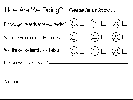 Front of paper postcard.
Front of paper postcard.
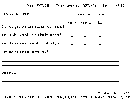 Electronic Postcard.
Electronic Postcard.
 Completed electronic postcard.
Completed electronic postcard.